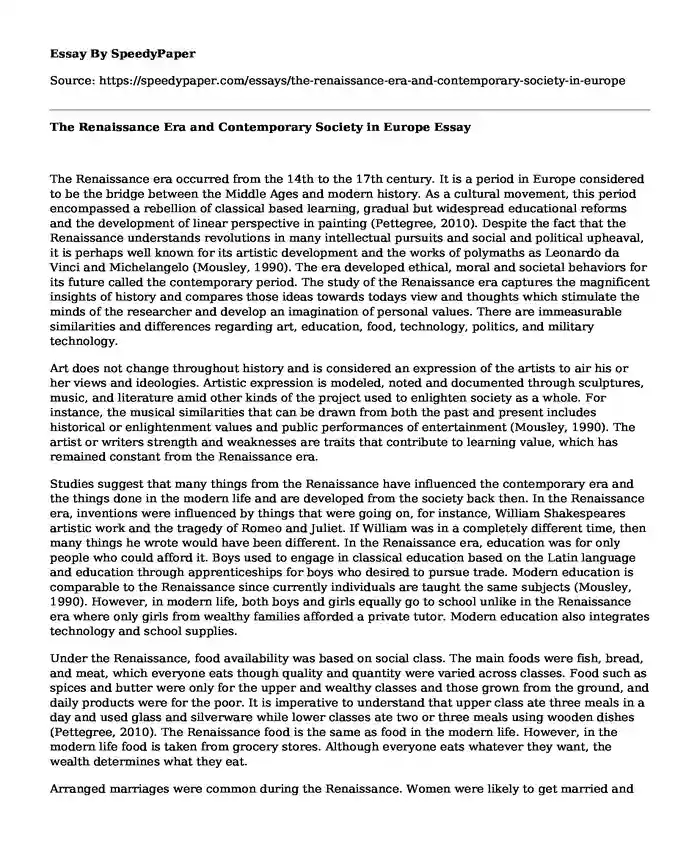The Renaissance era occurred from the 14th to the 17th century. It is a period in Europe considered to be the bridge between the Middle Ages and modern history. As a cultural movement, this period encompassed a rebellion of classical based learning, gradual but widespread educational reforms and the development of linear perspective in painting (Pettegree, 2010). Despite the fact that the Renaissance understands revolutions in many intellectual pursuits and social and political upheaval, it is perhaps well known for its artistic development and the works of polymaths as Leonardo da Vinci and Michelangelo (Mousley, 1990). The era developed ethical, moral and societal behaviors for its future called the contemporary period. The study of the Renaissance era captures the magnificent insights of history and compares those ideas towards todays view and thoughts which stimulate the minds of the researcher and develop an imagination of personal values. There are immeasurable similarities and differences regarding art, education, food, technology, politics, and military technology.
Art does not change throughout history and is considered an expression of the artists to air his or her views and ideologies. Artistic expression is modeled, noted and documented through sculptures, music, and literature amid other kinds of the project used to enlighten society as a whole. For instance, the musical similarities that can be drawn from both the past and present includes historical or enlightenment values and public performances of entertainment (Mousley, 1990). The artist or writers strength and weaknesses are traits that contribute to learning value, which has remained constant from the Renaissance era.
Studies suggest that many things from the Renaissance have influenced the contemporary era and the things done in the modern life and are developed from the society back then. In the Renaissance era, inventions were influenced by things that were going on, for instance, William Shakespeares artistic work and the tragedy of Romeo and Juliet. If William was in a completely different time, then many things he wrote would have been different. In the Renaissance era, education was for only people who could afford it. Boys used to engage in classical education based on the Latin language and education through apprenticeships for boys who desired to pursue trade. Modern education is comparable to the Renaissance since currently individuals are taught the same subjects (Mousley, 1990). However, in modern life, both boys and girls equally go to school unlike in the Renaissance era where only girls from wealthy families afforded a private tutor. Modern education also integrates technology and school supplies.
Under the Renaissance, food availability was based on social class. The main foods were fish, bread, and meat, which everyone eats though quality and quantity were varied across classes. Food such as spices and butter were only for the upper and wealthy classes and those grown from the ground, and daily products were for the poor. It is imperative to understand that upper class ate three meals in a day and used glass and silverware while lower classes ate two or three meals using wooden dishes (Pettegree, 2010). The Renaissance food is the same as food in the modern life. However, in the modern life food is taken from grocery stores. Although everyone eats whatever they want, the wealth determines what they eat.
Arranged marriages were common during the Renaissance. Women were likely to get married and have kids at a young age and stayed home with children while men went to work. On the contrary, both parents have the choice to either stay home or work in the modern day families (Pettegree, 2010). It is common to find many families with one parent and individuals choose whether or not to be married or have children.
In sum, we can see that although there were many similarities of the Renaissance era to our modern society in Europe, the differences far outweigh the similarities. The differences range from religion, food, art, politics, education, family roles and responsibilities, medicine, and fashion.
References
Mousley, A. (1990). Renaissance Selves and Life Writing: The Autobiography of Thomas Whythorne. Forum For Modern Language Studies, 26(3), 222-230.
Pettegree, A. (2010). The book in the Renaissance. New Haven, Conn.: Yale University Press.
Cite this page
The Renaissance Era and Contemporary Society in Europe. (2019, Sep 17). Retrieved from https://speedypaper.net/essays/the-renaissance-era-and-contemporary-society-in-europe
Request Removal
If you are the original author of this essay and no longer wish to have it published on the SpeedyPaper website, please click below to request its removal:
- Registered Nurse - Free Essay in Nursing
- Thesis Paper Example: Cash Management in FMCG Sector
- Free Essay on Homeland Cyber Security
- Essay Sample on Oscar Wilde's The Importance of Being Earnest
- Free Essay Describing the State of Matter on Other Planets
- Free Essay Sample - Drug and Substance Use As a Teenager
- Free Essay. Cambodia Should Set Up Rehabilitation Centers
Popular categories





